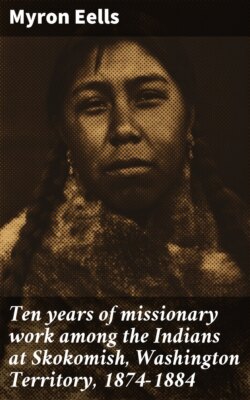Читать книгу Ten years of missionary work among the Indians at Skokomish, Washington Territory, 1874-1884 - Eells Myron - Страница 13
На сайте Литреса книга снята с продажи.
V.
THE FIELD AND WORK.
ОглавлениеTable of Contents
THE work has been about as follows: At Skokomish there were about two hundred Indians, including a boarding-school of about twenty-five children. Services were held every Sabbath morning for them in Indian. The Sabbath-school was kept up, immediately following the morning service. English services were held once or twice a month, on Sabbath evening, for the white families resident at the agency and the school-children. On Thursday evening a prayer-meeting was held regularly. It was in English, as very few of the non-English-speaking Indians lived near enough to attend an evening service, had they been so inclined. Various other meetings were held, adapted to the capacities and localities of the people: as prayer-meetings for school-boys, those for school-girls, and those at the different logging-camps.
Thirty miles north of Skokomish is Seabeck, where about thirty Indians live, most of whom gain a living by working in the saw-mill there. For several years I preached to the whites at this place, about eight times a year, and when there, also held a service with the Indians.
Twenty miles farther north is Port Gamble, one of the largest saw-mill towns on the sound. Near it were about a hundred Clallam Indians, most of whom became Catholics, but who have generally received me cordially when I have visited them two or three times a year. They, however, have obtained whiskey very easily, and between this and the Catholic influence comparatively little has been accomplished.
Thirty-five miles farther on is Port Discovery, another saw-mill town, where thirty or forty Indians have lived, whom I have often called to see on my journeys; but so much whiskey has been sold near them and to them, that it has been almost impossible to stop their drinking, and hence, very difficult to make much permanent religious impression on them. By death and removal for misconduct, their number has diminished so that at one time there were only one or two families left. But the opportunity for work at the mill has been so good that some of a fair class have returned and bought land and settled down.
Forty miles from Port Gamble, and seventeen from Port Discovery, is Jamestown, near Dunginess, on the Straits of Fuca. This is the center of an Indian settlement of about a hundred and forty. Previous to 1873 these Indians were very much addicted to drinking—so much so, that the white residents near them petitioned to have them removed to the agency, a punishment they dreaded nearly as much as any other that could be inflicted on them. The threat of doing this had such an influence that about fifteen of them combined and bought two hundred acres of land. It has been laid off into a village; most of the Indians have reformed, and they have settled down as peaceable, industrious, moral persons. I have generally visited them once in six months, and they have become the most advanced of the Clallam tribe. A school has been kept among them, a church organized, and their progress has been quite interesting—so much so, that considerable space will be devoted to them in the following pages.
Once a year I have calculated to go farther: and twenty miles beyond is Port Angelos, with about thirty nominal Indian residents. But few of them are settlers, and they are diminishing, only a few families being left.
Seven miles further west is Elkwa, the home of about seventy Indians. It was, in years past, the residence of one of the most influential bands of the Clallam tribe, but they are diminishing, partly from the fact that there have been but few white families among them from whom they could obtain work, and, with a few exceptions, they themselves have done but little about cultivating the soil. As they could easily go across the straits to Victoria in British Columbia, about twenty miles distant, where there is little restraint in regard to their procuring whiskey, because they are American Indians, they have been steadily losing influence and numbers. Four or five families have homesteaded land, but as it was impossible for them to procure good land on the beach, they have gone back some distance and are scattered. Hence they lose the benefits of church and school. Still the old way of herding together is broken up, and they obtain more of their living from civilized pursuits.
Thirty-five miles farther is Clallam Bay, the home of about fifty more. This is the limit of the Indians connected with the Skokomish Agency. They are about a hundred and fifty miles from it, as we have to travel. In 1880 they bought a hundred and sixty acres of land on the water-front, and are slowly following the example of the Jamestown Indians. This is the nearest station of the tribe to the seal-fisheries of the north-west coast of the Territory; by far the most lucrative business, in its season, which the Indians follow.
